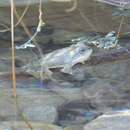Description
provided by AmphibiaWeb articles
Head without cranial crests; interorbital space narrower than the upper eyelid; tympanum distinct, about half the diameter of the eye; fourth toe with single subarticular tubercles; parotid squarish, as long as upper eyelid; dorsal tubercles unispinulate. Color: Dorsum gray, with greenish spotting; a dark blotch on the upper eyelid.For references in the text, see here
Schmidtler, J.J. and Schmidtler, J.F. (1969). ''Ãœber Bufo surdus; mit einem Schlussel und Anmerkungen zu den ubrigen Kroten Irans und West-Pakistans.'' Salamandra, 5, 113-123.
Distribution and Habitat
provided by AmphibiaWeb articles
Bufo surdus is a little known species. It is reported along western Balochistan and around Quetta. However, it is widely distributed in Iran (Schmidtler and Schmidtler 1969; Eiselt and Schmidtler 1973).
Life History, Abundance, Activity, and Special Behaviors
provided by AmphibiaWeb articles
Bufo surdus is nocturnal, spends day hiding under stones, vegetation, and falling logs, retreating into holes and crevices in the ground. It breeds during monsoons. Males gather in temporal pools and are very noisy. Eggs are laid in double strings which are wound around the pond vegetation. During the hot season when there is a general dearth of water, the toad seeks dampness under stones and in vegetation; such sites may hold several toads. Tadpole: A typical light to dark brown bufonid tadpole, with bulging globular body, comparatively weaker tail, and narrow low dark spotted fins. The oral disc is typical bufonid, with finely serrated beak; labial tooth row formula 2(2)/3, oral papillae are lateral. The tadpole feeds on the pond vegetation. Total length 21-22 mm, tail 16 mm.
Life History, Abundance, Activity, and Special Behaviors
provided by AmphibiaWeb articles
Use of fertilizers and pesticides pollute ponds and puddles which are used for breeding and do havoic to the eggs and tadpoles.Reclamation of wastelands help in habitat creation for this toad.
Relation to Humans
provided by AmphibiaWeb articles
The toad is best pest exterminater in agricultural areas. It also extends in human inhabitations to feeds on hermful insects and worms.
Bufotes surdus
provided by wikipedia EN
Bufotes surdus, also known as Iranian earless toad, Iranian toad, Pakistan toad, or Luristan toad (not to be confused with Lorestan toad), is a species of toad in the family Bufonidae. It is found in southern Iran and western Pakistan.[1][2] There is also an isolated record from eastern Iraq.[1]
Appearance and subspecies
Bufotes surdus is a medium-small toad with a snout–to–vent length of about 4–6 cm (1.6–2.4 in) in adults.[3][4] Unlike most species of Bufotes but similar to its close relative B. luristanicus, it has no visible tympanum (either absent or tiny and covered by the skin),[4][5] hence the common name "earless toad".[2] It is typically quite dull and plain-coloured, but it may have some inconspicuous greenish markings, especially to the limbs, and occasionally a larger amount of small greenish ring-shaped spots.[4]
Two subspecies are recognized,[2] but their separation is questionable (annulatus was described based on features that often are individually variable in toads) and require further study.[4][5]
-
Bufotes surdus annulatus (Schmidtler and Schmidtler, 1969)
-
Bufotes surdus surdus (Boulenger, 1891)
Common name ring-spotted earless toad can be used to specifically refer to Bufotes surdus annulatus.[2]
Habitat and conservation
Bufotes surdus inhabits oases and pools in irrigated areas and their surroundings at elevations of 0–2,250 m (0–7,382 ft) above sea level. Breeding takes place during the monsoons when males gather in temporal pools. The eggs are deposited around vegetation in ponds. During the dry season these animals seek damp areas under stones and within vegetation. It can be a locally common species, but its ecology is little known and it has sometimes been confused with juveniles of other Bufotes species. It is threatened by intensification of agriculture, including agricultural pollution. Extended periods of drought can cause local population declines. Some populations occur within protected areas.[1]
References
-
^ a b c d Muhammad Sharif Khan, Matthias Stöck, Theodore Papenfuss, Steven Anderson, Sergius Kuzmin, Nasrullah Rastegar-Pouyani, Mozafar Sharifi, Soheila Shafiei Bafti, Sushil Dutta.; Annemarie Ohler (2015). "Bufotes surdus". IUCN Red List of Threatened Species. 2015: e.T54772A74505632. doi:10.2305/IUCN.UK.2015-1.RLTS.T54772A74505632.en. Retrieved 17 November 2021.
{{cite journal}}: CS1 maint: multiple names: authors list (link) -
^ a b c d e Frost, Darrel R. (2020). "Bufotes surdus (Boulenger, 1891)". Amphibian Species of the World: an Online Reference. Version 6.0. American Museum of Natural History. Retrieved 20 February 2020.
-
^ Parvaresh, Z.; N. Seddighi; F. Roushenas; S. Rahimi; E. Hasani; Z. Mossadeghi; M. Nokhbatolfoghahai (2016). "Reproductive strategy and embryonic development of Bufotes surdus annulatus in Iran". Salamandra. 52 (3): 230–242.
-
^ a b c d Stöck, M.; R. Günther; W. Böhme (2001). "Progress towards a taxonomic revision of the Asian Bufo viridis group: current status of nominal taxa and unsolved problems (Amphibia: Anura: Bufonidae)". Zoologische Abhandlungen – Staatliches Museum für Tierkunde in Dresden. 51: 253–319.
-
^ a b Javari, M.; F. Torki (2009). "Notes on morphology, ecology, behavior and systematics of Bufo luristanicus SCHMIDT, 1952 (Anura: Bufonidae)". Herpetozoa. 21 (3/4): 171–178.

- license
- cc-by-sa-3.0
- copyright
- Wikipedia authors and editors
Bufotes surdus: Brief Summary
provided by wikipedia EN
Bufotes surdus, also known as Iranian earless toad, Iranian toad, Pakistan toad, or Luristan toad (not to be confused with Lorestan toad), is a species of toad in the family Bufonidae. It is found in southern Iran and western Pakistan. There is also an isolated record from eastern Iraq.
- license
- cc-by-sa-3.0
- copyright
- Wikipedia authors and editors

